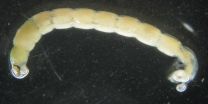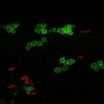Europe, Siberia and in between: Caucasian populations of non-biting midges
2015-07-01
(Press-News.org) A research in the North Caucasus, conducted by a group of Russian scientists over three years, has revealed an intermediate distribution of Caucasian populations of non-biting midges between Europe and Siberia. Their observations also proved some interesting morphological distinctions between the studied populations and the previously researched ones from Europe and Siberia. Their results have been published in the open-access journal Comparative Cytogenetics.
The study on karyotypical and morphological peculiarities of Ch. bernensis is a part of the investigation of the fauna and distribution of non-biting midges in the Northern Caucasus.
"Non-biting midges is a very interesting group of insects," said Dr. Karmokov, senior staff scientist in Tembotov Institute of Ecology of Mountain territories. "The fauna and distribution of many species are still almost unknown. We investigated the species Ch. bernensis of the genus Chironomus, observed by us in northern Caucasus for the first time. We found interesting distinctions in the morphology of the mouthparts of larvae, as well as new, not previously known for this species, rearrangement in the second chromosome."
The genus Chironomus is one of the most well-studied groups of non-biting midges. It consists of over 200 species. Dr. Karmokov explained that on comparing the populations from Caucasus with the already studied ones from Europe and Siberia, they found similarities between the Caucasian and the European. However, the former was occupying a special intermediate location, which might indicate a fairly large degree of isolation.
"The dominance of different genotypic combinations at various sites of the Caucasus probably can be explained by the fact that in some areas some combinations can be more adaptive than the others," the scientists suggest. "Perhaps this is happening due to a different level of mineralization, temperature and degree of eutrophication in the different collection sites."
Although the research team points out that more researches are needed for more specific information to be obtained, they propose that the geographical location of the studied regions reflects the true course of the species' settlement (either from west to east or from east to west). Dr. Karmokov conducted the current study with the help of Dr. Polukonova and Dr. Sinichkina from Saratov State Medical University named after V.I. Razumovsky.
INFORMATION:
Original source:
Karmokov MKh, Polukonova NV, Sinichkina OV (2015) Karyotype characteristics and polymorphism peculiarities of Chironomus bernensis Wülker & Klötzli, 1973 (Diptera, Chironomidae) from the Central Caucasus and Ciscaucasia. Comparative Cytogenetics 9(3): 281-297. doi: 10.3897/CompCytogen.v9i3.4519
[Attachments] See images for this press release:

ELSE PRESS RELEASES FROM THIS DATE:
2015-07-01
Sandcastles are a prime example of how adding a small amount of liquid to a granular material changes its characteristics. But understanding the effect of a liquid wetting randomly oriented fibres in a fibrous medium remains a mystery. Relevant to the building industry, which uses glass wool, for instance, this phenomenon can be better understood by studying the behaviour of a liquid trapped between two parallel fibres. It can either remain in the shape of a drop or spread between the fibres into a long and thin column of liquid. Now, scientists have demonstrated that the ...
2015-07-01
Failing to find a mating partner is a dent to the reproductive prospects of any animal, but in the flatworm species Macrostomum hystrix it might involve a real headache. Zoologists from the Universities of Basel and Bielefeld have discovered the extraordinary lengths to which this animal is willing to go in order to reproduce - including apparently injecting sperm directly into their own heads. The academic journal Proceedings of the Royal Society B has published their findings.
The absence of a mate usually spells disaster for sexually reproducing animals. However, some ...
2015-07-01
Atoms absorb and emit light of various wavelengths. Physicists have long known that there are some tiny changes, or shifts, in the light that gets absorbed or emitted, due to the properties of the atomic nucleus. Now, a team of scientists has elucidated the so-called hyperfine structure of cadmium atoms. Relying on a method called laser spectroscopy, they have measured variations in the energy transition within cadmium atom - Cd in the periodic table. They studied a chain of isotopes with an odd number of neutrons ranging from 59 in 107Cd to 75 in 123Cd. From these high-precision ...
2015-07-01
A good night's sleep has long been recommended to those who have experienced a traumatic event. But an Oxford University-led study provides preliminary experimental work suggesting it could actually be the wrong thing to do.
The research, conducted in Oxford's Wellcome Trust-funded Sleep and Circadian Neuroscience Institute (SCNi) and published in the journal Sleep, showed that sleep deprivation might prevent people from consolidating memories of experimental trauma (emotional film clips in the study), reducing their tendency to experience flashbacks.
Dr Kate Porcheret, ...
2015-07-01
(SACRAMENTO, Calif.) -- Soldiers injured during the conflicts in Iraq and Afghanistan have the highest survival rates in history, thanks to the availability of surgeons skilled in combat care. But combat-ready surgical skills are hard to sustain off the battlefield.
"A lot of knowledge builds up in the military medical enterprise during times of war," said Joseph Galante, who chairs the UC Davis Division of Trauma, Emergency and Critical Care Surgery and is a commander in the U.S. Navy Reserves. "When peacetime comes, that knowledge can slide. We need to identify ways ...
2015-07-01
The global supply of seafood is set to change substantially and many people will not be able to enjoy the same quantity and dishes in the future due to climate change and ocean acidification, according to UBC scientists.
These findings were released today in Japan by the Nereus program, an international research team led by UBC scientists and supported by the Nippon Foundation. The Nereus program was formed to study the future of the world's oceans and seafood resources. Today it released a summary of the first phase of its research in a report titled 'Predicting Future ...
2015-07-01
ASCO Perspective: Gary Schwartz, MD, ASCO Expert "This study adds to the growing discussion around food and cancer risk. While the findings are intriguing, it's far too soon to recommend any broad changes to grapefruit or orange consumption. Until conclusive data are available, we should continue to be cautious about protecting our skin from sun exposure."
A new analysis of dietary patterns among more than 100,000 Americans suggests that frequent consumption of citrus -- namely whole grapefruit and orange juice -- may be associated with an increased risk of melanoma. ...
2015-07-01
July 1 -- Researchers in the United Kingdom and Denmark have studied the "see-through" larvae of zebrafish to reveal how wound healing leads to skin cancer. Live imaging shows neutrophils, the protective inflammatory cells of the body's immune system, diverted from an induced wound to any nearby precancerous skin cells. The newly arrived neutrophils cause rapid division of these skin cells, which may cause them to progress to melanoma. The results are published in The EMBO Journal.
"Our results provide direct visual evidence of a physical link between wound-associated ...
2015-07-01
Scientists from the University of Leeds and The Institute of Cancer Research, London, have discovered a new protein which triggers the growth of blood vessels in breast cancer tumours which have spread to the brain, a common location which breast cancer can spread to.
Dr Georgia Mavria's team in the School of Medicine at Leeds found that by withholding the DOCK4 protein in mouse models, a particular part of the blood vessel did not form as quickly, meaning tumours grew at a slower rate.
Dr Mavria said: "We want to understand how these tumours form and grow, but we still ...
2015-07-01
Storing solar energy as hydrogen is a promising way for developing comprehensive renewable energy systems. To accomplish this, traditional solar panels can be used to generate an electrical current that splits water molecules into oxygen and hydrogen, the latter being considered a form of solar fuel. However, the cost of producing efficient solar panels makes water-splitting technologies too expensive to commercialize. EPFL scientists have now developed a simple, unconventional method to fabricate high-quality, efficient solar panels for direct solar hydrogen production ...
LAST 30 PRESS RELEASES:
[Press-News.org] Europe, Siberia and in between: Caucasian populations of non-biting midges




